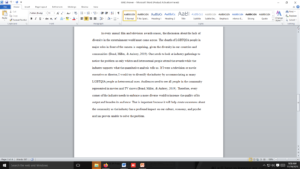Heterosexual Privilege
The following are the components of heterosexual privilege:
1. The assumption that everyone is heterosexual.
2. Heterosexuality is the only “normal” sexual orientation.
3. Social institutions, laws, and public policies may exclude the acknowledgment of other sexual orientations or deny rights to LGBTQIA+ individuals.
- What are some of the “single stories” we have in our culture about LGBTQIA+ people in our culture? How did you learn these stories?
- Consider the last 2-3 movies or TV shows you have watched. How many LGBTQIA+ characters were represented in them? How were these characters portrayed compared to straight characters?
- If you were a television or movie executive or director, how could you improve diversity in your industry? Why might this be important?
Requirements: 400 words or more
Below are the learning resources.
Bond, B.J., Miller, B., & Aubrey, J.S. (2019). Sexual References and Consequences for Heterosexual, Lesbian, Gay, and Bisexual Characters on Television: A Comparison Content Analysis. Mass Communication & Society, 22(1), 72-95. http://ezproxy.umgc.edu/login?
Haefele-Thomas, A. & Combs, T. (2019). Chapter 2: Sexual Orientation: Stories and Definitions. Introduction to Transgender Studies. Harrington Park Press, LLC. http://ezproxy.umgc.edu/login?
Tatum, E. (2015, March 29). 10 Examples of Straight Privilege. Everyday Feminism. https://everydayfeminism.com/
Watermark Retirement Communities. (2021, January 20). Not another second: LGBT+ seniors share their stories (Official film) [Video]. YouTube. https://youtu.be/q43kBuC_ups
Answer preview
In every annual film and television awards season, the discussion about the lack of diversity in the entertainment world must come across. The dearth of LGBTQIA people in major roles in front of the camera is surprising, given the diversity in our countries and communities (Bond, Miller, & Aubrey, 2019). One needs to look at industry gatherings to notice the problem as only whites and heterosexual people attend the awards while the industry supports what the quantitative analysis tells us. If I were a television or movie executive or director, I would try to diversify the industry by accommodating as many LGBTQIA people as heterosexual ones. Audiences need to see all people in the community represented in movies and TV shows (Bond, Miller, & Aubrey, 2019). Therefore, every corner of the industry needs to embrace a more diverse world to increase the quality of its output and broaden its audience. That is important because it will help create awareness about the community as the industry has a profound impact on our culture, economy, and psyche and has proven unable to solve the problem.
[587 Words]

Heterosexual Privilege

